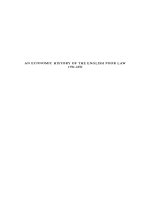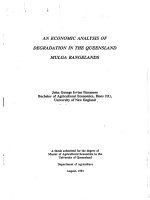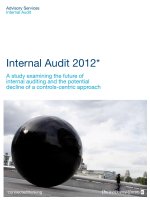the public financing of pharmaceuticals an economic approach
Bạn đang xem bản rút gọn của tài liệu. Xem và tải ngay bản đầy đủ của tài liệu tại đây (1.39 MB, 272 trang )
TeAM
YYePG
Digitally signed by TeAM YYePG
DN: cn=TeAM YYePG, c=US,
o=TeAM YYePG, ou=TeAM
YYePG, email=
Reason: I attest to the accuracy
and integrity of this document
Date: 2005.06.16 15:44:32 +08'00'
The Public Financing of Pharmaceuticals
The Public Financing
of Pharmaceuticals
An Economic Approach
Edited by
Jaume Puig-Junoy
Research Centre for Economics and Health (CRES),
Department of Economics and Business, Pompeu Fabra
University, Spain
Edward Elgar
Cheltenham, UK • Northampton, MA, USA
© Jaume Puig-Junoy 2005
All rights reserved. No part of this publication may be reproduced, stored in a
retrieval system or transmitted in any form or by any means, electronic,
mechanical or photocopying, recording, or otherwise without the prior
permission of the publisher.
Published by
Edward Elgar Publishing Limited
Glensanda House
Montpellier Parade
Cheltenham
Glos GL50 1UA
UK
Edward Elgar Publishing, Inc.
136 West Street
Suite 202
Northampton
Massachusetts 01060
USA
A catalogue record for this book is available from the British Library
Library of Congress Cataloguing in Publication Data
The Public financing of pharmaceuticals : an economic approach / edited by Jaume
Puig-Junoy.
p. cm.
1. Pharmaceutical industry—Government policy—United States. 2.
Pharmaceutical industry—United States—Finance. 3. Drugs—Research—United
States—Finance. I. Puig-Junoy, Jaume.
HD9666.6.P83 2005
338.4´7615´0973—dc22
2004058627
ISBN 1 84542 088 8
Typeset by Cambrian Typesetters, Frimley, Surrey
Printed and bound in Great Britain by MPG Books Ltd, Bodmin, Cornwall
Contents
List of figures vii
List of tables viii
Contributors x
List of abbreviations xii
1 Introduction: Public pharmaceutical expenditure 1
J. Puig-Junoy
PART I
2 Incentives for innovation in the pharmaceutical market 21
P. Ibern Regàs
3 Price regulation systems in the pharmaceutical market 35
J. Puig-Junoy
4 Regulation and competition in pharmaceutical markets 59
J.R. Borrell Arqué, A. Costas Comesaña and R. Nonell Torres
5 Mechanisms to encourage price competition in the
pharmaceutical market and their effects on efficiency and welfare 84
J. Rovira Forns and J. Darbà Coll
PART II
6 Reference pricing as a pharmaceutical reimbursement mechanism 103
G. López-Casasnovas and J. Puig-Junoy
7 Insurance in public financing of pharmaceuticals 124
B. González López-Valcárcel
8 Economic evaluation and pharmaceutical policy 145
J.L. Pinto Prades and X. Badía Llach
9 Prescriber incentives 167
L. Cabiedes and V. Ortún
PART III
10 Economic considerations regarding pharmaceutical
expenditure in Spain and its financing 189
G. López-Casasnovas
v
11 Review of economic studies of the pharmaceutical industry
published over the last 20 years by Spanish economists 210
F. Lobo, M. Cabañas Sáenz and R. González Pérez
Appendix List of economic studies of the pharmaceutical industry
and pharmaceuticals published over the last 20 years by
Spanish economists 235
Index 245
vi The public financing of pharmaceuticals
Figures
2.1 Welfare loss of a monopoly 24
5.1 Result of establishing a single price and Ramsey prices 96
6.1 The Kinked Demand model 112
7.1 Demand functions, co-payment levels and welfare loss 129
7.2 The pharmaceutical market: co-payment levels and welfare loss 130
7.3 Effects of raising the co-payment from 10 per cent to 40 per
cent: distribution of the pharmaceutical expenditure between
patient and insurer 133
8.1 Decision tree for regulatory policy 158
vii
Tables
1.1 Public pharmaceutical expenditure as a percentage of public
health expenditure 4
1.2 Cost sharing in the health systems of western European
countries 8
1.3 Pharmaceutical expenditure as a percentage of total health
expenditure 12
3.1 Main forms of price regulation in EU countries in 1997 40
3.2 Criteria used in the price regulation of pharmaceuticals in
the OECD 42
4.1 Retail sales of pharmaceutical products 62
4.2 Therapeutic classifications 64
4.3 Number of active ingredients, pharmaceutical products and
pharmaceutical presentations 65
4.4 Therapeutic competition in the pharmaceutical market as a
whole (%) 66
4.5 Therapeutic competition: number of active ingredients 67
4.6 Therapeutic competition: market share of the most prescribed
active ingredient (%) 68
4.7 Therapeutic competition: H index of prescription
concentration between various therapeutic substances (%) 69
4.8 Generic competition (%) 71
4.9 Length of time substances have been on the market (%) 72
4.10 Generic competition: number of products per active 73
ingredient
4.11 Generic competition: market share of the most prescribed
product (%) 75
4.12 Generic competition: H index of product prescription
concentration (%) 77
4.13 Prescription of different preparations per product 78
4.14 Average price per item prescribed in the public health sector 81
4.15 Number of items prescribed per patient 82
5.1 Factors affecting price competition on the supply side and
the demand side 91
5.2 Comparison of the results of the hypothetical application of
a single price or Ramsey prices in a two-country model 95
viii
6.1 Evolution of public health expenditure in Spain (1989–2001)
(%) 104
6.2 National expenditure on health care and pharmaceuticals in
Europe (1997) 107
6.3 Some international experiences in the application of RP 109
6.4 The kinked demand model 111
7.1 Effects of cost sharing on financing, use and equity 128
8.1 Costs and benefits of social programmes 153
8.2 Costs and benefits of non-dominated alternatives 154
8.3 Ordering of programmes according to incremental
cost–benefit ratios 155
8.4 Probabilities and utilities of each regulatory policy 159
8.5 Example of a utility function 164
9.1 Measures aimed at influencing prescription 170
9.2 Measures aimed at influencing prescription as applied in
some EU countries 172
9.3 Prescriber incentive policies 175
10.1 Distribution by categories of the 50 top-selling drugs in the
world, years: 1988–2002 (estimate) (number of products) 193
10.2 Weighted average price of pharmaceuticals in the main EU
countries in 2001 (Spain 100) 194
10.3 Spanish Social Security drug consumption through
pharmacies (retail price plus VAT) (1988–2001) 195
10.4 Public pharmaceutical expenditure as a percentage of GDP 196
10.5 Public pharmaceutical expenditure as a percentage of total
public health expenditure 196
10.6 Some other (financing) pharmaceutical indicators, 2000 197
10.7 Total drug consumption in the EU in euros per person per
year, 2000 198
10.8 Pharmaceutical consumption and expenditure in Spanish
Social Security prescriptions per insured person per year
(1995–2001) in pesetas/year 198
10.9 Average sum per prescription of pharmaceutical products
in the Spanish Social Security market (retail price plus VAT)
1992–2001 199
10.10 Pharmaceutical expenditure in Europe by categories in
1999 (in million US$) 199
10.11 Some cost-containment measures in the pharmaceutical sector 202
Tables ix
Contributors
X. Badía Llach Consultant, Clinical Epidemiology and Public Health
Department, Health Outcomes Research Unit, Sant Pau Hospital, Barcelona
J.R. Borrell Arqué Interim full lecturer, Faculty of Economic and Business
Sciences, University of Barcelona
M. Cabañas Sáenz Documentalist, Health and Pharmaceuticals Social
Studies Seminar, Carlos III University, Madrid
L. Cabiedes Full lecturer, Applied Economics, University of Oviedo
A. Costas Comesaña University professor, Faculty of Economic and
Business Sciences, University of Barcelona
J. Darbà Coll Full lecturer, Department of Economic Theory, University of
Barcelona
B. González López-Valcárcel University professor, Faculty of Economic
and Business Sciences, University of Las Palmas de Gran Canaria
R. González Pérez Research assistant, Health and Pharmaceuticals Social
Studies Seminar, Carlos III University, Madrid
P. Ibern Regàs Research Centre for Economics and Health (CRES); associ-
ate lecturer, Department of Economics and Business, Pompeu Fabra
University, Barcelona
F. Lobo Director of the Health and Pharmaceuticals Social Studies Seminar,
Carlos III University, Madrid
G. López-Casasnovas Research Centre for Economics and Health (CRES);
university professor, Department of Economics and Business, Pompeu Fabra
University, Barcelona
R. Nonell Torres Full lecturer, Faculty of Economic and Business Sciences,
University of Barcelona
V. Ortún Research Centre for Economics and Health (CRES); full lecturer,
Department of Economics and Business, Pompeu Fabra University,
Barcelona
x
J.L. Pinto Prades Research Centre for Economics and Health (CRES),
Department of Economics and Business, Pompeu Fabra University,
Barcelona; university school professor
J. Puig-Junoy Research Centre for Economics and Health (CRES); univer-
sity school professor, Department of Economics and Business, Pompeu Fabra
University, Barcelona
J. Rovira Forns Senior health economist, The World Bank Health,
Nutrition and Population, Washington and lecturer, University of Barcelona
Contributors xi
Abbreviations
AES Associación de Economía de Salud
AIDS acquired immune deficiency syndrome
ASTRO-PU age, sex and temporary resident originated prescribing unit
BOE Boletín Oficial del Estado
CBA cost–benefit analysis
CEA cost-effectiveness analysis
CMg constant marginal cost
COPD chronic obstructive pulmonary disease
CP price paid by the consumer
CPI consumer price index
CRES Research Centre for Economics and Health
CS consumer surplus
CUA cost-utility analysis
DDD defined daily dose
DH Department of Health
EE economic evaluation
EFG especialidad farmacéutica genérica
EFP ex-factory price
EU European Union
FDA Food and Drug Administration
GATT General Agreement on Tariffs and Trade
GDP gross domestic product
GP general practitioner
HMO health maintenance organization
IMS Intercontinental Medical Systems
INE Instituto Nacional de Estadística
INN International Non-proprietary Name
Insalud Instituto Nacional de Salud
MAC maximum allowable cost
MOH Ministry of Health
MUFACE Mutualidad de Funcionarios de la Administración Central del
Estado
NHS National Health Service
NSEA non-safe and effective drug approved
NSER non-safe and effective drug rejected
xii
OECD Organization for Economic Co-operation and Development
OTC over the counter
PA probability of the drug being accepted
PBM Pharmacy Benefit Management firm
PCG primary care group
PCR price-cap regulation
PNSE probability of the drug not being safe and effective
PPP purchasing power parity
PPRS Pharmaceutical Price Regulation Scheme
PR probability of the drug being rejected
PSE probability of the drug being safe and effective
QALY quality-adjusted life-year
R&D research and development
RORR rate of return regulation
RP reference price; reference pricing
SEA safe and effective drug approved
SER safe and effective drug rejected
SNS Sistema Nacional de Salud
SS Seguridad Social
TRIP Trade-related aspects of intellectual property
UK United Kingdom
USA United States of America
WHO World Health Organization
WTO World Trade Organization
Abbreviations xiii
1. Introduction: Public pharmaceutical
expenditure
J. Puig-Junoy
PHARMACEUTICALS AND EFFICIENT HEALTH
PRODUCTION
In the analysis of health care the price of care is often confused with the level
of expenditure, particularly so in the analysis of the cost of pharmaceuticals.
Pharmaceutical cost containment should never be the exclusive goal of public
policies: emphasis on costs without paying attention to the value of the prod-
ucts may lead to inefficient policies. The value of a new pharmaceutical
resides in its ability to improve health, not just in its contribution to the
decrease or increase of health care costs. Increased spending on health care
and pharmaceuticals is therefore compatible with a reduction in their price, if
the resulting value increases more than the expenditure.
According to a common cliché, health care spending on pharmaceuticals is
excessive in Spain, although the figures do little to endorse this idea, and
moreover do not in themselves serve to lay blame or pinpoint inefficiencies.
Public and private pharmaceutical spending per capita in Spain is not among
the highest in the European Union (EU): it is almost 10 per cent lower than the
European average, and lower than the figure for nine of the 15 Member States.
The proportion of spending on pharmaceuticals within health care expenditure
as a whole stands at around 20 per cent (20.7 per cent in 1997), according to
data published by the Organization for Economic Co-operation and
Development (OECD). This indicator shows wide variation internationally,
from less than 10 per cent in Denmark, Ireland and Switzerland to 26.5 per
cent in Hungary and 35 per cent in Bulgaria. The proportion is greater in
lower-income countries than in higher income ones.
The allocation of a greater or lesser proportion of the total health expendi-
ture to pharmaceuticals merely indicates that there are different ways of
combining resources to produce health care. The superiority of one combina-
tion of resources over another can only be established by examining the aggre-
gate results of the resources used on the health status of the population.
The economic cost of the pharmaceuticals for the patient and society as a
1
whole is not well represented by the observation of higher or lower pharma-
ceutical expenditure. The opportunity cost of pharmaceuticals must take into
account the benefit they provide, and also the problems that may arise from
pharmacological treatment (prescription and medication errors and various
types of interaction, incomplete treatment, adverse reactions to pharmaceuti-
cals and bacterial resistance). The degree of suitability of the prescription is an
illustration of problems related to the benefits of pharmaceuticals.
INTERPRETING MEASURES OF HEALTH CARE
SPENDING ON PHARMACEUTICALS
The interpretation of the available empirical evidence of the absolute and rela-
tive magnitude of pharmaceutical expenditure on an aggregate or macroeco-
nomic level is often prone to the effects of confusing the level of expenditure
with the cost or price of care. It is of great value to identify two very import-
ant aspects for measuring and interpreting pharmaceutical expenditure.
Firstly, we should review the problems associated with the available
empirical evidence in aggregate-level statistical sources for the health system
that are used most frequently in the analysis of pharmaceutical expenditure.
Secondly, the conditions to be fulfilled by the measures of the relative import-
ance of pharmaceutical spending within health care spending should be clearly
established, thus enabling us to observe what type of variation is occurring,
and the nature of the underlying explanatory factors that are responsible for
the evolution of the observed spending. This would allow valid comparisons
between forecast and actual spending.
According to OECD figures, pharmaceutical spending accounted for 22 per
cent of Spain’s public health care expenditure in 2001. This is considerably
more than in a large number of countries, only Portugal (24 per cent in 1997),
and Hungary (25.3 per cent) registering higher percentages. Furthermore, this
2001 figure for Spain represented a considerable increase over the figure for
1987 (14.9 per cent). However, at present the proportion is clearly smaller than
that observed in Spain at the beginning of the 1970s (34.8 per cent in 1973),
and it remained steady from 1979 to 1994 (see Table 1.1).
Yet public pharmaceutical expenditure per capita is lower in Spain than in
many OECD countries. In 2001 public spending on pharmaceuticals stood at
US$251 per person, less than in countries such as France (US$354) Germany
(US$284), Japan (US$269) and Luxembourg (US$268 in 2000).
These examples highlight that the interpretation of this relative magnitude,
chosen by many authors as an indicator of the exception that Spain constitutes
as regards pharmaceutical drug consumption, is questionable at best. This
empirical measure is far from representing the combination of pharmaceutical
2 The public financing of pharmaceuticals
and non-pharmaceutical resources adopted by each health system (relative
amount of resources or technology) for several reasons. The participation and
contribution of the pharmaceutical resource to health production should be
evaluated on the basis of data indicating the consumption of factors of produc-
tion that are not contaminated by the origin of the funding. Thus, for example,
cross-national comparisons of public pharmaceutical spending at a particular
time are affected by major differences in levels of co-payment (that is, user
participation in the funding of pharmaceuticals) between countries (see Table
1.2). The variation over time of the level of co-payment in Spain (a markedly
decreasing trend) is bringing about changes in the share of public health
expenditure devoted to pharmaceutical spending that do not reflect any rise in
relative consumption of the pharmaceutical resource but rather private financ-
ing that is not only one of the lowest in the EU but moreover is decreasing.
Given that there is a crossover between public and private pharmaceutical
financing in the production of health services (users with coverage who prefer
to pay the retail price of the drug to the inconvenience of obtaining the
prescription from the public primary care provider; direct-payment prescrip-
tions made out in a private surgery that are subsequently reclassified as
prescriptions made out by a public primary care provider), the observation of
empirical data on public pharmaceutical spending is not meaningful as an indi-
cator of resource combination in health production. There are more advantages
to be had in observing the total pharmaceutical expenditure as compared to the
total health expenditure (Table 1.3). If we observe the behaviour of this indi-
cator, we can see that although the Spanish rate is high (20.7 per cent in 1997),
nevertheless: (a) it is lower than or on a par with countries such as France,
Greece, Hungary, Japan, Portugal and the Czech Republic, although higher
than the rest of the OECD countries, and (b) its 1997 value is still slightly
lower than its 1980 value.
Cross-national comparisons of pharmaceutical spending are likewise extra-
ordinarily misleading, as the final pharmaceutical expenditure includes taxes
and intermediaries’ markups, both of which are very different from country to
country.
The analysis of the contribution made by increased pharmaceutical spend-
ing to the growth in the per capita intensity of health resources suffers from
major measurement problems that deprive available indicators of any value.
Traditional pharmaceutical price indexes (such as the Laspeyres index, used to
calculate the pharmaceutical component of the consumer price index) provide
little relevant information in a market in which the introduction of therapeutic
innovations is of prime importance; the indexes show an apparent freeze, and
sometimes even a steep drop (as in the Spanish case). However, the steady rise
in the average price per prescription paints a very different picture.
The rise in the average price of medicines can be attributed to any of
Introduction 3
4 The public financing of pharmaceuticals
Table 1.1 Public pharmaceutical expenditure as a percentage of public
health expenditure
1960 1961 1962 1963 1964 1965 1966 1967 1968 1969
Australia 16.3 18 17.6 14
Austria
Belgium
Canada 0.2 0.2
Czech Rep.
Denmark
Finland 1.4 5 4.9 5 5.5 5.4
France
Germany
Greece
Hungary
Iceland 11.1 14.7 12 9.8 9.5 10 9.4 9.7 8 11.9
Ireland
Italy
Japan
Korea
Luxembourg
Mexico
Netherlands
New Zealand
Norway 2.4 2.6 3 3.2 3.2
Poland
Portugal
Spain
Sweden 11.2 11.2 12.5 13.1 12 17.2 21.2 27.6 31.3 32.7
Switzerland
Turkey
UK
USA 8.1 5.9 5.9 6.3 7.4 12.2 11.6 11.5 10.3 10.5
1980 1981 1982 1983 1984 1985 1986 1987 1988 1989 1990
Australia 5.5 6.1 6.1 5.7 5.4 5.3 5.7 6.4 6.3 6.6 6
Austria
Belgium
Canada 2.8 2.9 2.9 3.1 3.4 3.8 4.1 4.3 4.5 4.8 5.1
Czech Rep. 19.2
Denmark 3.4 3.3 3.1 3.3 3.4 3.5 3.7 3.6 3.9 3.6 3.1
Finland 6.3 6.1 5.7 5.7 5.6 5.5 5.4 5.6 5.5 5.5 5.5
France 13.6
Germany 12.5 12.5 12.4 12.6 12.8 12.8 13 13.5 13.6 13.7 13.7
Greece 20.3 15.4 14.7 15.1
Hungary
Iceland 9.2 8.9 9.5 12.5 11.3 11.8 11.2 10.2 10 11.3 12.8
Introduction 5
1970 1971 1972 1973 1974 1975 1976 1977 1978 1979
12.3 11.1 11.1 10.2 7.6 6 6.3 6 5.6
0.3 0.5 0.6 0.8 1.1 1.7 2 2.2 2.5 2.7
5.8 6.6 7.2 7.2 7.5 7.1 7.1 7 6.8 6.6
14.1 13.5 13.4 13.1 13 12.7 12.8 12.4 12.4 12.5
36
11.2 10 7.3 7.2 7.5 9.2 7.6 7.2 8.9 7.9
13.6 2.7 4.8 5.7 7.5 7.6 7.3 7 6.9
18.5 15.4 15.5 14.5 14.3 14
10.2 10 9.2 8.9 8.6 8.4 8.2 7.9
11.3 11.8 10.6 11 10.1 10.2 11 11.2 10.6 10.3
3.1 3.3 3 3.1 3.4 3.4 3.3 3.3 3.4 3.6
15.6 19.6 19.1 19.7 21.4
32.3 34 33.4 34.8 29.5 27 20.6 18.8 18.9 17.7
4.8 5 5.5 6.2 5.9 5.9 5.6 5.5 5.4 5.3
10 9.8 9.7 9.4 10.3 8.7 9.5 10.3 10.6 10
1991 1992 1993 1994 1995 1996 1997 1998 1999
67 7.9 8.2 9.1 9.2 8.7 8.9 9.3
11 11.3 13.6 14.8 15.5
10.1 9.9 10.3 11.2 11.5
5.3 5.7 5.9 5.9 6.4 6.4 6.6 6.9 7.3
16.9 19.7 17.8 22.7 23.1 22.9 22.3 22.7 19.6
4.7 5 5 5.1 5.3 5.2 5.2 5.4 5.2
5.9 6.2 7.2 8.1 8.4 8.8 9.3 9.2 9.8
13.8 13.8 14.1 13.8 14.2 14.3 14.8 15.4 16.4
14 11.6 11.4 11.4 11.5 11.2 11.6 12.3
18.9 20 20.5 21.9 21.4 22.3 22.9 18.6 18.9
24.5 21.4 22.5 21.9 19.9 20.8 26.4 24.8
11 11.9 10.8 11.9 12.4 13 12.3 11.5 11
2000 2001 2002
10.7 10.9
16.2 17 17.3
7.8 8.2 8.4
18.8 18.4
5.2 5.5
10.4 10.7
17.4 18.2
12.6 13.5
17.4 18.9
24.9 25.3
several factors: (a) ‘pure’ variations in the price of existing products, (b) the
appearance and spread of the consumption of new products with a higher than
average price and a greater or lesser degree of therapeutic innovation, and (c)
a shift in consumption from low-priced products to products with a higher
price than those consumed previously, which may entail a greater or lesser
degree of therapeutic innovation (shifts between different presentations,
between different brands with the same active ingredient, and between differ-
ent therapeutic subgroups).
The important question to answer is to what extent the increase in pharma-
ceutical prices involves an increase or a decrease (and of what magnitude) in
the cost of health care. In other words, to what extent is the rise in pharma-
ceutical expenditure contributing to increase, maintain, or reduce the cost of
obtaining an additional quality-adjusted life-year (QALY)? The first indis-
pensable step towards eradicating the confusion that exists between pharma-
ceutical expenditure and cost of care is, in addition to choosing the right
monetary magnitude, to avail ourselves of appropriate price indexes for drug
consumption.
An accurate measure of the apparent causes of the evolution of pharma-
ceutical expenditure could be obtained by taking chain-linked Laspeyres
price indexes for each therapeutic group with a suitable level of disaggrega-
tion. In this situation, ideally we would have monetary measures of willing-
6 The public financing of pharmaceuticals
Table 1.1 (continued)
1980 1981 1982 1983 1984 1985 1986 1987 1988 1989 1990
Ireland 7.1 8 8.5 7.7 7.9 7.9 8.5 9 9.9 11.2 11
Italy 16.7 16.9 16.8
Japan 16.5 15.4 16.1 17.2 16.9 18.1 16.9
Korea 0 0.3
Luxembourg 13.5 13.4 13.6 13.3 13.7 14.2 14.6 13.9 14.1 14.3 13.6
Mexico
Netherlands 7.7 7.6 7.8 7.2 7.9 8.3 8.6 8.9 9.1 8.6 9.5
New Zealand 10.9 9.3 10.4 10.6 11.4 12.3 13.8 14 13.8 14 12.5
Norway 4.3 4.3 4.4 4.4 4.5 4.6 4.4 4.2 6 6.3 6.9
Poland
Portugal 21.2 22.6 22.5 21.9 30.1 29.4 33.9 27.5 28 23.7
Spain
Sweden 16.8 16.6 17 15.6 15.1 15.7 14.9 14.9 17.5 16.7 16.2
Switzerland 5 4.7 5.2 5.4 5.1 5.4 5.6 5.9 5.1 6.3 6.4
Turkey
UK 21.3 22.6 24.3 28.1 29.6
USA 9.7 9.6 10.5 10.3 10.5 10.5 10.7 10.6 11 11.1 10.8
Source: OECD Health Data (2003).
ness to pay for the improvement in quality of the main products, resulting
from economic evaluations carried out using techniques such as contingent
valuation, or by estimating the statistical value of life by means of hedonic
prices. In this way we could determine the part of the price increases that are
attributable to improvements in the quality of the products on the one hand
and pure price rises on the other. The problems to solve in the construction of
pharmaceutical price indexes are biases that are well known from the
construction of inflation and welfare indexes: substitution bias, bias due to
the appearance of new goods or services, and the consideration of changes in
quality.
A number of empirical approaches have been put forward to quantify the
price level and changes in prices of a treatment or a QALY: constructing price
indexes (that is, learning to separate inflation from better inputs) for pharma-
ceuticals for a given disease taking into account the value of the innovation,
changes in the structure of consumption, and so on; avoiding intertemporal
comparisons of pharmaceutical cost per person, per stay, per illness, and so on,
which add to the confusion between expenditure and the price of health; and
developing measures of the monetary value of improvements in the quality of
pharmaceutical innovations in order to establish the right relationship between
spending and the price we are paying for additional QALYs (the true index of
variation in the cost of health or life).
Introduction 7
1991 1992 1993 1994 1995 1996 1997 1998 1999
10.6 11.1 10.7 11.1 11.3 11.7 11 11.4 11.8
15.6 14.6 13.2 11.1 11.1 11.3 11.4 12 12.7
18.7 18 18.5 17.6 19.5 18.8 17.9 15.7 15.1
0.3 0.3 0.6 1.1 1.6 1.6 1.6 1.5 1.8
13.7 14.2 10.8 10.6 10 11.2 10.7 11
0
9.3 13.2 13.6 13.5 13.7 10.5 10.4 9.3 9.7
12.6 12.7 13.3 13.5 13.4 13 13.1
21 18.1 17.2 18.1 20.3 19.6 13.3 12.5 13
24.4 25.5 25 24.8 23.8 23.6 24
28.9
16.9 17.2 17 17.8 19 19.6 20.9 21 21.6
7 7.9 8.8 10 10.4 11.6 9.6 10.9 11.4
9.9 10 10.4 10.6 11
4
10.7 10.6 11 11.3 11.5 11.8 12.7
2000 2001 2002
11.6 12.7
13.4 16 15.5
15.5 16.2
6.2
11.2
0.1 0.2
9.7 9.7
15.7 15.8
31.4 31.5
21.8 22
11.4 10.9
11.7 11.6
8
Table 1.2 Cost sharing in the health systems of western European countries
Country First contact with the system
Referrals (within the system)
Pharmaceuticals
Austria
Does not affect 80% of the population. Combination of co-payment and percentage
Co-payment for prescription drugs. Drugs not
A percentage rate of co-payment for health rate (with exemptions).
The scheme of prescribed by health professionals are excluded
care is applied to the rest, unless exempted direct payments by the patient is limited to
for reasons of low income
the first 28 days of hospitalization
Belgium
Wide range of co-payments and percentage Co-payment varying with the systems of
Co-payment and percentage rates of cost
rates of cost sharing, with the exception of
payment of the professionals. Benefits are sharing that range from 0% to 85% accor
ding to
the low-income bracket. Patients are entitled reduced after 90 days, less so for the low-
the type of drug consumed. Pharmaceuti
cals
to opt for an extra billing system
a
income bracket
not included in the system’s positive financing list
are not covered in any way
Denmark
None
None
Variable percentage rate of cost sharing (0–50%)
applied on the basis of drug reference prices (RP).
Drugs outside the MOH formulary are excluded
from the coverage of the system
Finland
None. A choice is made between: a prior
Maximum payment levels for (daily) Percentage rates of user sharing in
annual payment, a co-payment, and a hospital stays and for specialist visits
pharmaceutical costs
co-payment with a maximum in the
user-shared bill for the annual cost. Varies
according to the municipality
France
Percentage rates of cost sharing. Extra Percentage rates of cost sharing per diem,
Mostly subject to percentage rates of cost
billing is permitted for certain categories together with co-payments covering meals.
sharing. There is a positive list of
of doctors
Direct payments by the user are not pharmaceuticals with public coverage
applicable after the first 30 days
Germany
None.
Flat rate of co-payment for the first 14 Variable co-payment. RP
system. No coverage
days per year of hospitalization, after is applied to those pharmaceuticals on public
which there is no cost sharing of any sort financing negative lists
Greece
None, although extra billing is common None for hospital stays. Some schemes
Percentage rates of user sharing in
practice among private doctors
practice shared financing through user pharmaceutical costs
cost-sharing rates for diagnostic services
9
Iceland
Co-payments, with higher rates for visits None for hospital stays. Combination of
Combination of daily deductibles per
outside normal working hours. Larger co-payment and percentage rate of cost
prescription and percentage rates of cost sharing
co-payments for house calls. A maximum sharing for specialist care and out-patient
up to a maximum level. Some medicines are
is set for the financial participation of the visits. Co-payment in diagnostic services.
completely free, while others are excl
uded
user
A maximum is set for the financial
from public coverage
participation of the user
Ireland
None for category I of the population None for category I in public hospitals.
None for population category I. Deductibles are
(represented 37% in 1987). The
For the rest, co-payments are applied for applied to the rest of the population which also
participation is 100% for the rest of the the first out-patient visit per episode, and
act as monthly maximum levels of user
population unless they take out health there is a per diem co-payment for the
participation. Pharmaceuticals included in the
insurance against it. An annual deductible first 10 days of hospitalization per year
. negative list of public funding are not c
overed
is applied to insured groups which also acts Insurers buy free care for both public and
as a maximum level of user participation
private hospitals
Italy
None
None for in-patient care. Cost sharing was Deductibles are only applied for medicines that
introduced in 1990 for public hospitals are considered essential. Most of the rest are
with regard to diagnostic procedures, financed through a combination of deductables
hospital visits and spa treatments
and percentage rates of cost sharing. Some phar-
maceuticals are excluded from public coverage
Luxembourg
Percentage rates of user sharing in the cost Inflation-linked per diem co-payments
Percentage rates of cost sharing, except in the case
of services
of ‘special diseases’. Medicines are free during
hospitalization
Netherlands
None for public insurance, but varies in the None for public insurance, but varies in the
RP system, with the exclusion of some
case of private insurance
case of private insurance
pharmaceuticals
Norway
Cost sharing, with a maximum annual None for in-patient care. Cost sharing for
RP system for medicines that are considered
contribution for all services as a whole diagnostic services
essential
Portugal
Cost sharing
Cost sharing
Two percentage cost sharing rates, depending on
the type of pharmaceuticals involved. Some
pharmaceuticals are free, while others are excluded
from public coverage
Spain
None
None
Percentage rates of sharing in the cost of
pharmaceutical consumption. Positive list of
pharmaceuticals with public coverage









